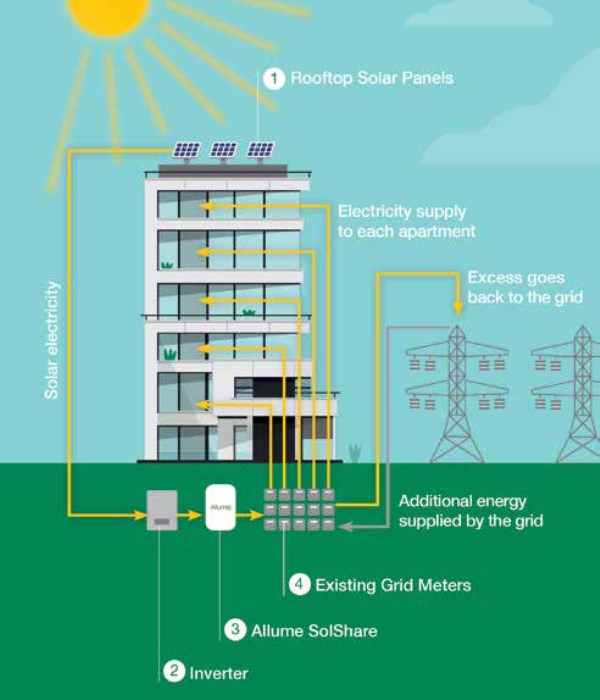Working from Home & Using Less Energy

Are you working from home due to COVID-19, or is this your new normal? If this is the case, you are likely to be using more energy. How do you save money on energy while you are using more energy? A paradox….No, something new and exciting….Yes. In this article, we will learn how to reduce energy usage from the grid, improve your sustainability and carbon footprint, while living in a strata community, all while using more energy!
The Power of Solar
Solar is well established in Australia, supported by the extraordinary amount of sunshine we enjoy. The solar panels turn sunlight into energy, and as solar technology improves, panels are becoming more sensitive to sunlight and even produce energy on relatively cloudy days, as such increasing the overall efficiency and effectiveness of solar installations.
Traditional Solar for Strata
Solar in multi-tenanted stratum is installed to support the common property’s energy usage in most cases. Traditionally, installing solar for individual lots is not only problematic and expensive, but due to technical and physical obstacles, it’s not possible or practical in most cases.

Residents in strata of course have the option to purchase green energy from energy retailers or participate in peerto-peer energy trading by buying and selling renewable electricity through a blockchain cryptocurrency environment. But these options can seem intangible compared to using the electrons you generate yourself at home.
Solar Feeds into Individual Apartments
Solar for individual lots in strata is now relatively easy thanks to some cuttingedge, world first Australian behind-themeter technology supported by the Australian Government’s Australian Renewable Energy Agency (ARENA).
ARENA has provided support to Victorian based Allume Energy to develop and manufacture their solar sharing technology in Australia. The behind-the-meter solar sharing solution can distribute solar energy generated from a single solar system to multiple, separately metered units within a multi-tenanted building such as residential lots, common property & retail tenancies.
So how does this work? Quite simply, this is facilitated with the addition of an energy management and distribution device that sits between the inverter and electricity meters. The solar energy sharing technology works in parallel with existing electricity infrastructure and does not interfere with energy authority metering, and customers can stay with their current energy retailers. When the solar array is installed in a building, the solar installer includes the solar sharing technology.

The solar energy can be distributed equitably to the residents in the strata using sophisticated algorithms to prioritise solar energy delivery to individual lots based on actual energy demand. The Owners Corporation / Body Corporate can control the energy distribution through solar energy management software. Finally, any excess energy supplied can be exported to the electricity grid or stored in batteries.
Once the initial decision to install solar is made and the Committee have voted to generate green energy, then their discussions can migrate to ‘how big do we go?’ With the introduction of the solar sharing technology, the committees can now consider upsizing the solar array to include residential users’ needs. The result may be a larger solar array on the roof. The committee’s preferred solar installer can provide advice on a suitable solution to meet the specific needs of their complex.
Case Studies1
Victorian Apartment Complex
› 44 Apartments Connected
› 66 kW Solar Panels
› Approximately 28% energy reduction from the grid
› Over $350 savings per apartment p.a.
› Over 186 tonnes of CO² equivalent saved for the whole complex in year 1

NSW Luxury Apartment Complex
› 3 Apartments plus Common Property Light & Power Connected
› 16 kW Solar Panels
› First 4 months (during COVID) the solar met 28% of electricity needs saving residents $1,000
› Payback less than 5 years
How is the Solar Sharing Technology Funded?
The major part of the cost of installing the solar array with the solar sharing technology is the solar array itself. The decision to add the solar sharing technology only adds nominal costs per lot.
• Residential developers can include the solar array & solar sharing technology in greenfield developments and ownership is handed over to owners.
• The Owners Corporation / Body Corporate can pay for the retrofitting of the solar installation & solar sharing technology.
• Some electricity retailers will fund and maintain the solar system & solar sharing technology, offering residential customers a ‘solar + grid supply’ package option. In this scenario, residents still have the choice to participate with the solar retailer or their preferred energy supplier.
• A third-party funds the solar array & solar sharing technology and sells the green energy to residents. This can work with solar power purchase agreements or embedded networks.

Take Advantage of Solar Power Benefits
According to the Clean Energy Regulator’s latest Small-Scale Renewable Energy Scheme data, more than 2.46 million solar PV systems have been installed on households, community centres, schools and small businesses. This has resulted in cumulative installed capacity of 11.4 gigawatts.2
While previously residents in strata were only easily able to enjoy solar vicariously through common property installations, the tide has changed. Individual residents can enjoy the direct economic and environmental benefits of solar energy. Our Strata Community can support the growth of green solar energy generation in Australia.
View Comments
(0)